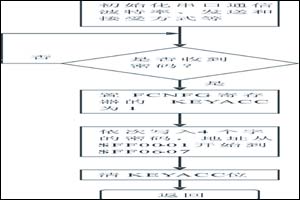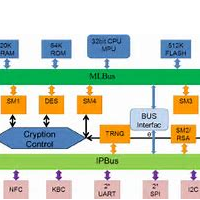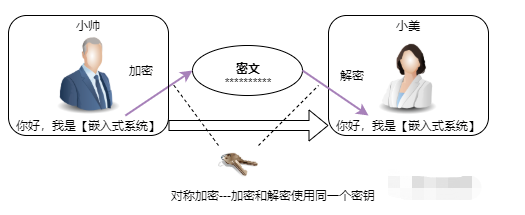RSA算法
RSA公开密钥密码体制。所谓的公开密钥密码体制就是使用不同的加密密钥与解密密钥,是一种“由已知加密密钥推导出解密密钥在计算上是不可行的”密码体制。
在公开密钥密码体制中,加密密钥(即公开密钥)PK是公开信息,而解密密钥(即秘密密钥)SK是需要保密的。加密算法E和解密算法D也都是公开的。虽然解密密钥SK是由公开密钥PK决定的,但却不能根据PK计算出SK。
正是基于这种理论,1978年出现了著名的RSA算法,它通常是先生成一对RSA 密钥,其中之一是保密密钥,由用户保存;另一个为公开密钥,可对外公开,甚至可在网络服务器中注册。为提高保密强度,RSA密钥至少为500位长,一般推荐使用1024位。这就使加密的计算量很大。为减少计算量,在传送信息时,常采用传统加密方法与公开密钥加密方法相结合的方式,即信息采用改进的DES或IDEA对话密钥加密,然后使用RSA密钥加密对话密钥和信息摘要。对方收到信息后,用不同的密钥解密并可核对信息摘要。
RSA算法是第一个能同时用于加密和数字签名的算法,也易于理解和操作。RSA是被研究得最广泛的公钥算法,从提出到现今的三十多年里,经历了各种攻击的考验,逐渐为人们接受,截止2017年被普遍认为是最优秀的公钥方案之一。
加密过程:
A提取消息m的消息摘要h(m),并使用自己的私钥对摘要h(m)进行加密,生成签名s
A将签名s和消息m一起,使用B的公钥进行加密,生成密文c,发送给B。
解密过程:
B接收到密文c,使用自己的私钥解密c得到明文m和数字签名s
B使用A的公钥解密数字签名s解密得到H(m)。
B使用相同的方法提取消息m的消息摘要h(m)
B比较两个消息摘要。相同则验证成功;不同则验证失败。
RSA加密过程简述
A和B进行加密通信时,B首先要生成一对密钥。一个是公钥,给A,B自己持有私钥。A使用B的公钥加密要加密发送的内容,然后B在通过自己的私钥解密内容。
数字签名的作用是保证数据完整性,机密性和发送方角色的不可抵赖性
假设A要想B发送消息,A会先计算出消息的消息摘要,然后使用自己的私钥加密这段摘要加密,最后将加密后的消息摘要和消息一起发送给B,被加密的消息摘要就是“签名”。
B收到消息后,也会使用和A相同的方法提取消息摘要,然后使用A的公钥解密A发送的来签名,并与自己计算出来的消息摘要进行比较。如果相同则说明消息是A发送给B的,同时,A也无法否认自己发送消息给B的事实。
其中,A用自己的私钥给消息摘要加密成为“签名”;B使用A的公钥解密签名文件的过程,就叫做“验签”。
RSA加密与解密代码
/// 《summary》
/// RSA 公钥加密
/// 《/summary》
/// 《param name=“content”》要加密的内容《/param》
/// 《param name=“publickey”》公钥《/param》
/// 《returns》《/returns》
public static string EncryptByPublicKey(string content, string publickey)
{
byte[] s = Convert.FromBase64String(publickey);
AsymmetricKeyParameter publicKey = PublicKeyFactory.CreateKey(s);
IBufferedCipher c = CipherUtilities.GetCipher(“RSA/ECB/PKCS1Padding”);
//公钥加密
c.Init(true, publicKey);
byte[] byteData = Encoding.UTF8.GetBytes(content);
byteData = c.DoFinal(byteData, 0, byteData.Length);
return Convert.ToBase64String(byteData);
}
/// 《summary》
/// RSA加密
/// 《/summary》
/// 《param name=“content”》加密明文《/param》
/// 《param name=“privatekey”》私钥《/param》
/// 《returns》返回密文《/returns》
public static string RSAEncry(string content, string privatekey)
{
AsymmetricKeyParameter privateKey = PrivateKeyFactory.CreateKey(Convert.FromBase64String(privatekey));
IBufferedCipher c = CipherUtilities.GetCipher(“RSA/ECB/PKCS1Padding”);
//私钥加密
c.Init(true, privateKey);
byte[] byteData = Encoding.UTF8.GetBytes(content);
byteData = c.DoFinal(byteData, 0, byteData.Length);
return Convert.ToBase64String(byteData);
}
/// 《summary》
/// RSA解密
/// 《/summary》
/// 《param name=“content”》密文《/param》
/// 《param name=“privatekey”》私钥《/param》
/// 《returns》明文《/returns》
public static string RSADeEncry(string content, string privatekey)
{
try
{
MemoryStream bufferStream = new MemoryStream();
byte[] bytData = Convert.FromBase64String(content);
int inputLength = bytData.Length;
AsymmetricKeyParameter privateKey = PrivateKeyFactory.CreateKey(Convert.FromBase64String(privatekey));
IBufferedCipher cipher = CipherUtilities.GetCipher(“RSA/ECB/PKCS1Padding”);
cipher.Init(false, privateKey);
int offSet = 0;
byte[] cache;
int i = 0;
while (inputLength - offSet 》 0)
{
if (inputLength - offSet 》 128)
{
cache = cipher.DoFinal(bytData, offSet, 128);
}
else
{
cache = cipher.DoFinal(bytData, offSet, inputLength - offSet);
}
bufferStream.Write(cache, 0, cache.Length);
i++;
offSet = i * 128;
}
byte[] decryptedData = bufferStream.ToArray();
bufferStream.Close();
return Encoding.UTF8.GetString(bufferStream.ToArray());
}
catch (Exception e)
{
return e.Message;
}
}
 电子发烧友App
电子发烧友App






























评论